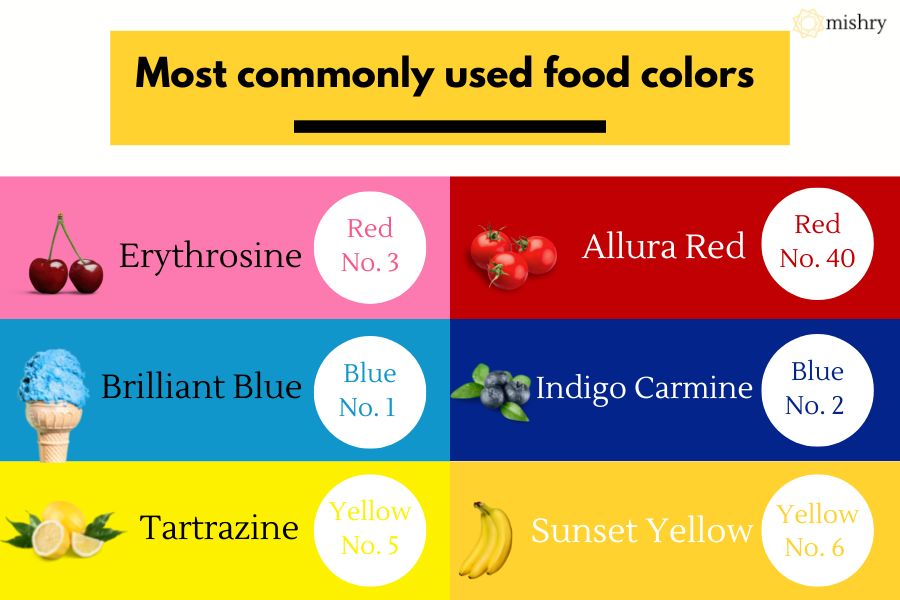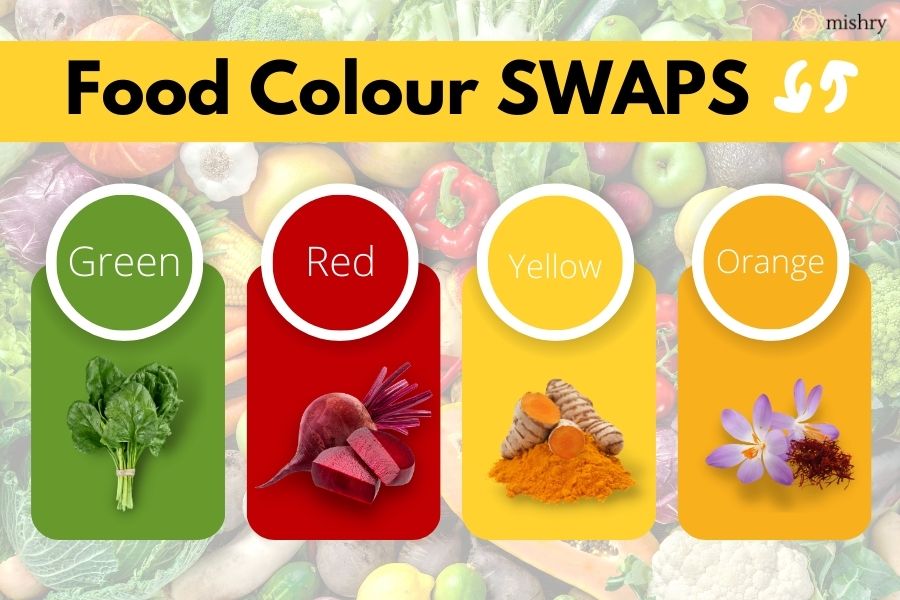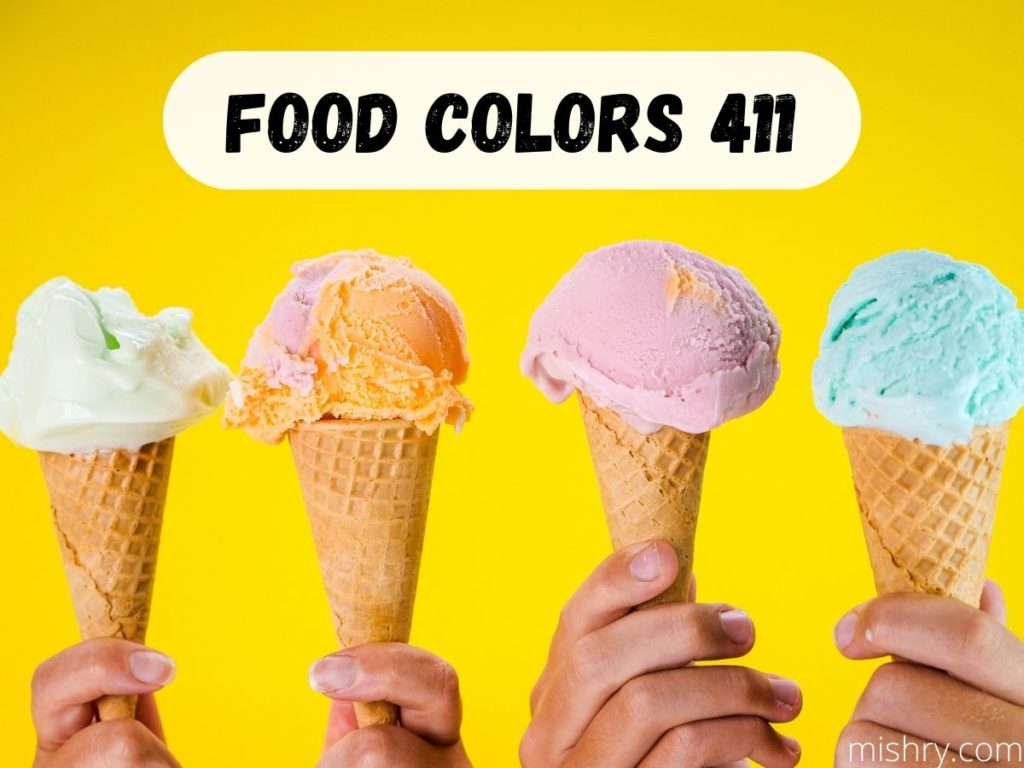You eat with your eyes first, they say. Well, we believe it’s the camera that eats first. But you get the gist, food is tasted visually before your palate gets a hit.
A crucial additive that enhances the appeal of several food products is food color. Be it the green hues in your packaged soup, the attractive amber in your jalebis, or the rainbow-colored sprinkles on those irresistible cupcakes, these are artfully presented for one simple reason. To trick your mind into thinking they are more delicious than they might really be. (and also, make them Instagram-able).
Here’s all that you need to know about food colors!
Did you know? The first fully synthetic food color was prepared in 1856 by oxidization of aniline. It was called mauveine. Aniline is an indigo shrub.
Table of Contents
What is Food Color?
In essence, food color is dyes, pigments, or other additives that enhance the appearance of fresh and processed foods and beverages. These can be natural (plant-derived) or synthetic (processed in a lab). Food color is offered in various forms like liquids, powders, gels, pastes and is added to a range of products like candies, soda, icing, baked goods, among many other items.
Foods Most Commonly Enhanced with Synthetic Colors
The coffee-brown tones you see in bread loaves or cola-flavored beverages is lent by INS 150 D, also known as caramel color. Certain brands of peanut butter may contain this too.
Packaged jalebi or jalebi kits (ones with which you can make some at home) may get their colors from the additive yellow 6, called sunset yellow. Though permitted and one of the most used food color, based on certain animal studies, yellow 6 may be the most significant reason behind kidney issues.
Another commonly used synthetic food color is INS 150 A which is made by processing sucrose through heat treatment. This lends a deep green/brown appearance to RTE hara bhara kebabs, packed chutneys/dips.
Most breakfast items like cereals and yogurts get their vibrancy from blue 1, blue 5, red 40, yellow 6, among others.

Food Color & Its Types
Primarily, there is natural and synthetic food color. Natural food color is derived from vegetable sources which are a combination of metallic and organic compounds, while synthetic is made from coal/tar.
When considering the forms (or states) of these colors, there is liquid, liquid gel, gel paste, powder, among others.
Liquid dye is the most inexpensive of all options. Its versatility is commendable, you can creates light tints and vibrant hues. This is typically offered in small plastic squeeze bottles with a dropper. Liquid dye may be water, glycerin, or syrup-based.
Liquid gel is similar to the above variant in terms of the container and base. However, consistency-wise, this is thicker and very concentrated. So a little goes a long way. Owing to the thick consistency, this is best suited for icing and creams, rather than doughs and batters.
Gel paste dye is also made with water, glycerin, or corn syrup but is semi-solid. Again, this is more appropriate for pastes than doughs.
If you’re someone trying to eliminate synthetic dyes completely, there is the option of natural dues. These are devoid of glycerin or corn syrup and usually come from a variety of plant sources. There is saffron, turmeric, beet, orange, carrots, etc. Natural food colors are your best bet for earthy tones.
Powdered colors can be added to doughs, batters, icing creams, and other items. Alternatively, this can also be dusted onto foods for some finesse.
Why Are Food Colors Used?
To explain simply, food color is added to enhance the appearance, make it more appealing, and sellable. These are generally considered safe, both natural and certain synthetic colors. Food experts are of the opinion that color plays a significant role in taste and perception of food. Adding to these, color also has an impact on flavor and texture.
How Are They Made? What Ingredients Are Used?
All food coloring comes from two broad sources. One is plants, animals, other organic material, and the other are petroleum-based or chemically produced with coal tar.
Natural food color is, goes without saying, safer to eat and use over the man-made counterpart. The simple reason is that the latter is heavily processed. Some of the most common natural food colorings are carotenoids, chlorophyll, anthocyanin, turmeric, etc. Newer shades like matcha, cyanobacteria, and spirulina are creating a buzz now.
Synthetic food color, on the other hand, is derived from petroleum, crude oil, and other substances in labs.
Let’s dive deeper into one of the most commonly used food colors- red, and see how it is made.
From cupcakes to frappucinos, most of the red coloring agents used in food is natural. But gross. This is derived from crushed bugs. Cochineal insects are dried and ground by manufactures, into a fine powder. When this powder is mixed with water, a bright red is the result.
In 2012, due to several questions being raised over the use of crushed bugs for color, many manufacturers switched to lycopene- a tomato-based extract.
Is The Use Of Food Colors Safe?
Because perception plays such a significant role in consumption and sales of packed foods and beverages, FSSAI has set certain regulations for this additive. One of the most crucial rule is that these additives must be within the permitted limit.
Next, they must be manufactured in a manner that adheres to food color standards set by FSSAI, meaning be free of impurity.
From- The Food Safety and Standards (Food Product Standards and Food Additives) Regulations, 2011 (Pg no: 503-507, 512, 513, 529, 530).
Linda Katz, Director of Office of Colors in FDA’s Food Safety Centre says, ‘there is no such thing as absolute safety of any substance.’
FDA regulates the color additives to be used and classifies them under two categories- certifiable and exempt.
Certifiable color additives are usually man-made. The manufacturer will submit a sample requesting for certification. If and only if, this sample meets the composition and purity requirement will the FDA certify it and it can be used in FDA-regulated products.
Exempt color additives are obtained from plant, animal, or mineral sources. These are not subject to batch verification but must comply with regulatory requirements.
PS- it is crucial to note that an approval for one intended use does not imply approval for other uses.

So, What Are Food Color Allergies? How Do I Steer Clear Of Them?
Food color is commonly added to products like ice cream, canned fruits, chips, candies, cereal, etc.
If there’s an absurd reaction by the immune system, a synthetic food color has most likely triggered an allergy.
These allergies may present themselves as facial swelling, hives, shortness of breath, headaches, inflammation, among others.
Tartrazine, which lends yellow hues, is one of the most allergic coloring.
Annato, gives a butter-like appearance, may show mild to moderate reactions.
However, carmine, a non-synthetic food color, may also show allergic reactions when consumed.
Swap The Synthetics For Natural Colors
While one can never be too sure of what goes in packaged foods and beverages or items served at a restaurant, if you’re looking to amp up the look of your homemade dishes, here are some easily-available, natural swaps to synthetic food coloring that you can try.
For a deeper red, boil some peeled, cleaned beetroots and use the water they were boiled in.
If you need some green hues, try making a paste of blanched spinach leaves. Ensure the leaves are immediately dunked in ice cold water as it helps retain a vibrant green shade.
For yellow, all you need is turmeric powder. In case of orange, you could add some saffron strands.
Verdict
What’s better natural or artificial?
Synthetic colors are more cost-effective and have a longer shelf life. Plus, there is no limit on the variety. Like there are two sides to a coin, there are some drawbacks to using synthetic colors.
Natural colorings are extracted or processed entirely from ingredients such as vegetables, tubers, and fruits which are available in nature. Besides helping foods more attractive, natural colorings were also recognized to increase the nutritional value of the foods, making natural food colors the better option.


